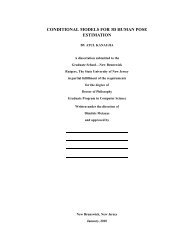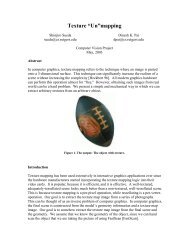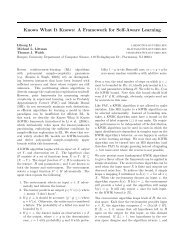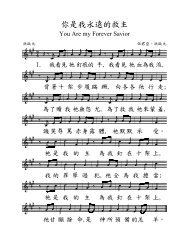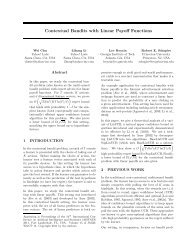Composition theorems in communication complexity
Composition theorems in communication complexity
Composition theorems in communication complexity
You also want an ePaper? Increase the reach of your titles
YUMPU automatically turns print PDFs into web optimized ePapers that Google loves.
In the Boolean block composed function case, the regularity condition reduces to the<br />
matrix [g(x, y)] be<strong>in</strong>g balanced, and later we will prove that the orthogonality condition<br />
reduces to the strongly balanced property. From this theorem we can see that the way to<br />
partition Ψ <strong>in</strong>to Ψ Easy and Ψ Hard does not really matter for the lower bound proof pass<strong>in</strong>g<br />
through. However, the partition does play a role when we later bound the spectral norm <strong>in</strong><br />
the denom<strong>in</strong>ator.<br />
5.2 Functions with group symmetry<br />
For a general f<strong>in</strong>ite group G, two elements s and t are conjugate, denoted by s ∼ t, if there<br />
exists an element r ∈ G s.t. rsr −1 = t. Def<strong>in</strong>e H as the set of all class functions, i.e. functions<br />
f s.t. f(s) = f(t) if s ∼ t. Then H is an h-dimensional subspace of L C (G), where h is the<br />
number of conjugacy classes. The irreducible characters {χ i : i ∈ [h]} form an orthogonal<br />
basis of H. For a class function f and irreducible characters χ i , denote by ˆf i the coefficient<br />
of χ i <strong>in</strong> expansion of f accord<strong>in</strong>g to χ i ’s, i.e. ˆfi = 〈χ i , f〉 = 1<br />
|G|<br />
fact is that for any i, we have<br />
| ˆf i | = 1<br />
|G|<br />
∑<br />
χ i (g)f(g)<br />
∣<br />
∣ ≤ 1 ∑<br />
|f(g)||χ i (g)| ≤<br />
|G|<br />
g∈G<br />
g∈G<br />
( 1<br />
|G|<br />
∑<br />
g∈G<br />
∑<br />
g∈G χ i(g)f(g). An easy<br />
)<br />
|f(g)|<br />
· max |χ i (g)|. (5)<br />
g<br />
If G is Abelian, then it always has |χ i (g)| = 1, thus max i | ˆf i | ≤ 1 ∑<br />
|G| g∈G<br />
|f(g)|. For general<br />
groups, we have |χ i (g)| ≤ deg(χ i ), where deg(χ i ) is the degree of χ i , namely the dimension<br />
of the associated vector space.<br />
In this section we consider the sett<strong>in</strong>g that S is a f<strong>in</strong>ite group G. The goal is to exploit<br />
properties of group characters to give better form of the lower bound. In particular, we hope<br />
to see when the second condition holds and what the matrix operator norm ‖[ψ ( g(x, y))] x,y ‖<br />
is <strong>in</strong> this sett<strong>in</strong>g.<br />
The standard orthogonality of irreducible characters says that ∑ s∈G χ i(s)χ j (s) = 0. The<br />
second condition <strong>in</strong> Theorem 11 is concerned with a more general case: For a multiset T with<br />
elements <strong>in</strong> G × G, we need<br />
∑<br />
χ i (s)χ j (t) = 0, ∀i ≠ j. (6)<br />
(s,t)∈T<br />
The standard orthogonality relation corresponds to the special that T = {(s, s) : s ∈ G}. We<br />
hope to have a characterization of a multiset T to make Eq. (6) hold.<br />
We may th<strong>in</strong>k of the a multiset T with elements <strong>in</strong> set S as a function on S, with the<br />
value on s ∈ S be<strong>in</strong>g the multiplicity of s <strong>in</strong> T . S<strong>in</strong>ce characters are class functions, for each<br />
pair (C k , C l ) of conjugacy classes, only the value ∑ g 1∈C k ,t∈C l<br />
T (g 1 , t) matters for the sake of<br />
Eq. (6). We thus make T a class function by tak<strong>in</strong>g average with<strong>in</strong> each class pair (C k , C l ).<br />
That is, def<strong>in</strong>e a new function T ′ as<br />
T ′ (s, t) =<br />
∑<br />
T (s, t)/(|C k ||C l |), ∀s ∈ C k , ∀t ∈ C l .<br />
s∈C k ,t∈C l<br />
Proposition 2. For a f<strong>in</strong>ite group G and a multiset T with elements <strong>in</strong> G×G, the follow<strong>in</strong>g<br />
three statements are equivalent:<br />
1. ∑ (s,t)∈T χ i(s)χ j (t) = 0, ∀i ≠ j<br />
2. T ′ , as a function, is <strong>in</strong> span{χ i ⊗ χ i : i ∈ [h]}<br />
3. [T ′ (s, t)] s,t = C † DC where D is a diagonal matrix and C = [χ i (s)] i,s . That is, T ′ , as a<br />
matrix, is normal and diagonalized exactly by the irreducible characters.


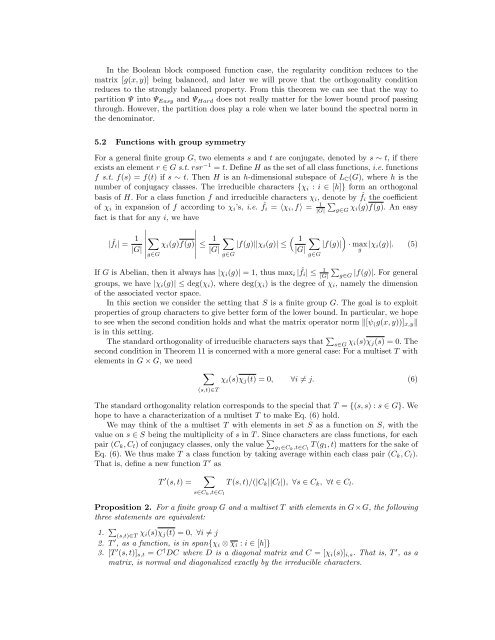
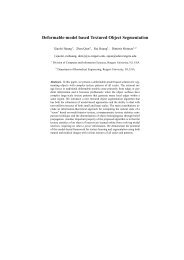
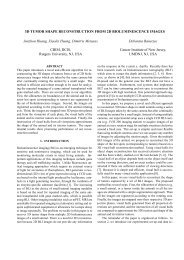
![Twitter[PDF]](https://img.yumpu.com/25710531/1/190x143/twitterpdf.jpg?quality=85)
